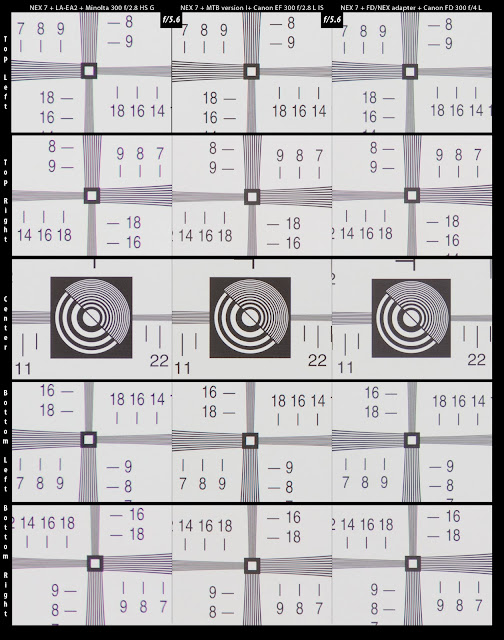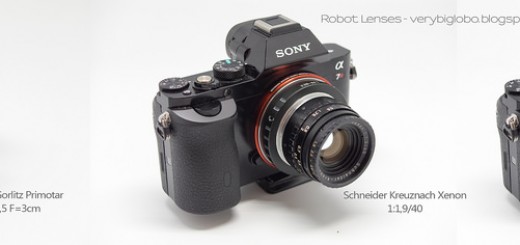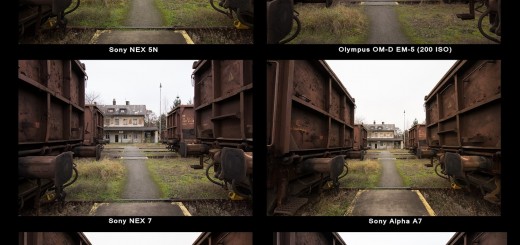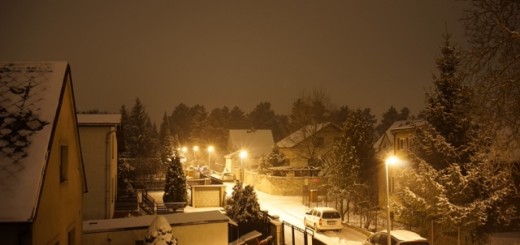NEX 7 + Minolta AF 300 f2.8 APO G HS + Canon EF 300 f2.8 L IS + Canon FD 300 f4 L
Contender 1 – Minolta AF 300 f2.8 APO G HS
This lens was produced as a non “G” version from 1985 till 1988, when G version replaced it. (the version tested here)
The latest and reported as the best of Minolta 300 super-tele – Minolta AF 300 F2.8 APO G D SSM, was introduced in 2003.
First two versions are optically same, they differ in a faster AF and two AF-stop buttons on the barrel. You can distinguish them by those buttons, or the sign High Speed on the lens hood.
Last “New” price was 3000 USD when it was available. eBay prices are around 2000 USD. I paid 2000, and then 160 USD for the repair (barrel was loose, so I paid for fixing that, and as far as I learned, it is very often failure on this lens).
Lens comes in a sturdy case, with five “drop-in” filters, from which, only ND is useful for color digital. Under the leather cap, there is a huge 114mm – clear protective filter also included. Drop-in polarizer was also available as a separate offer.
Minolta introduced some interesting solutions with this lens. Manual focus is possible when unlocking metal ring, that cover rubber focusing ring. That way, when locked in the position, MF is not possible by accidental touch of the ring. Focus limiter is another interesting solution – it is mechanical ring that you can move together with a focus ring up to desired starting position, and then simply tightening it.
I admire those “clever” mechanical solutions, and always prefer them above electronic ones.
Lens is very heavy at 2480 gr, but with 239 mm, it does not look extremely big, because of relatively slim body. Front element is huge however (well it has to be, it is FF lens), and it is hidden behind protective filter and built-in lens hood. This is another clever design from Minolta, as you don‘t need to bother with a hood, putting it on and off, when carrying the lens. On the other hand, hood is rather small (at least in comparison to the Canon EF 300 f2.8 L IS one), so I don’t know, how well it works.
Minolta AF 300 f2.8 APO G HS has minimum focus distance of 2.5m, but in my test, I was able to focus closer to approx. 2.3m (same as with Canon EF 300 f2.8 L IS)
To use this lens on NEX body, you need the adapter from A-mount to E-mount.
Lens does not have aperture ring, aperture is controlled by camera body, so if you need aperture control, only available options are Sony LA-EAx adapters.
LA-EA1 is the cheapest, but if you invested in such a lens, you would probably want to use LA-EA2, with PD AF built in. That’s what I used for this test.
Contender 2 – Canon EF 300 f2.8 L IS
There is not much to write about this lens… 2894 gr of steel and glass, (with lens ring and hood, 2550 gr – lens alone), super fast and silent – ring USM AF (with Canon bodies), IS up to 3 EV (works also on NEX with Metabones adapter), around 400 mm long (with hood attached – 260mm without), drop-in filters, weather sealed, comes in a luxury – polycarbonate case. Introduced in 1999, it was replaced by the new model (version II) in 2011.
This lens is legend, and you will see in the following test, that IQ this lens deliver is from another world. But it comes with a price above 3500 USD for used, as the new is not available any more. (Last “New” price was around 5000 USD)
Minimum focus distance is 2.5 m according to the producer, but I was able to focus closer at approx. 2.4m
This lens can be used on NEX with a Canon EF/E-mount adapter.
There are many of those available, from simple ones, across tilt adapters, adapters with built-in aperture control (like Minolta AF 300 f2.8 APO G HS , this lens does not have aperture ring either), but the ones that you should look for, include electric protocol for communication with NEX body.
Conurus/Metabones was first to introduce such a compact adapter (there were some other earlier, but with a two connected units and even more expensive), but today, there are some other, like Techart or R.J’s work i.e.
The first version of Metabones (that I am using for this test) didn’t allow AF, unlike the newest (version II) and Techart. However, reported AF speed is rather on a slow side, so don’t expect to AF on anything, that moves faster than a speedy snail.
Contender 3 – Canon FD 300 f4 L
Finally, real legacy pal. Introduced around 1978, this relatively light 1060 gr. and small – 207mm lens is very well regarded by Canon FD fans.
It certainly represent great value, I bought mine in 2009 for around 300 USD. That is for the lens made of 7groups/7elements with 2 UD (ultra-low dispersion) glasses and rear group focusing design. (lens does not change its length when focused)
Unlike other two lenses, presented above, Canon FD 300 f4L is fully manual lens, with a proper aperture ring.
Like his bigger friends here, it has “drop-in” (34mm) filter holder, for using special filters, it is very well built – metal and glass, it has built in tripod ring, that can be taken off (unlike Minolta AF 300 f2.8 APO G HS), and very nicely dampened focus ring and 9 aperture blades.
Being a manual lens, you can use cheap manual adapter without loosing any feature. Canon FD to E-mount adapter can be found for some 20 USD and less.
* (You should learn about those adapters, before using them, as you have to open and close aperture lever, with a ring on the adapter).
** (As with all “Drop-in” filters, if you are about to buy lens that uses them, you should check if the basic filter is supplied. It is a part of the optical formula, and you might experience some problems without it.)
How does lenses compare to each other?
With hood extended (attached), Canon EF 300 f2.8 L IS is almost twice as long as Canon FD 300 f4L 🙂
Canon EF 300 f2.8 L IS has really huge (and expensive), and most vulnerable and least practical hood, from any lens that I owned. But the optical output from this lens is so good, that you can forgive it many things…
Without hoods extended (attached), difference in size is much smaller, but you would most probably never use those lenses naked.
ISO 12333 test:
Please note, that this chart was shot at or even bellow indicated minimum focus distance. Some lenses are known to perform better at longer distances, and I will try all of those lenses outside at infinity settings, once the atmospheric conditions will be good.
On the other hand, close focus distances did show some aberrations, that at longer distances could be even emphasized.
Here is the comparison between two fast lenses at f2.8, presented as a 100 % crops from most important areas.
 |
| ISO 12333, 100% crops of Minolta AF 300 f2.8 APO G HS (left) and Canon EF 300 f2.8 L IS (right) at f2.8 on NEX 7 |
All three lenses at f4
 |
| ISO 12333, 100% crops of Minolta AF 300 f2.8 APO G HS (left) and Canon EF 300 f2.8 L IS (middle) and Canon FD 300 f4 L (Right) at f4 on NEX 7 |
And finally at f5.6
 |
| ISO 12333, 100% crops of Minolta AF 300 f2.8 APO G HS (left) and Canon EF 300 f2.8 L IS (middle) and Canon FD 300 f4 L (Right) at f5.6 on NEX 7 |
As you can see from this crops, Minolta suffer from heavy CA in the corners.
Canon FD 300 f4L, performs really well in the corners, but lacks contrast and could be slightly sharper in the center at f4.
What to say about Canon EF 300 f2.8 L IS? Your eyes should tell you, all you need to know. There is maybe slight astigmatism in the lower right corner, but I am almost sure it is caused by adapter and not the lens.
When I finish this test, with more shots from outside and at infinity focus settings, overall conclusion can be slightly different, but so far, Minolta is the softest lens at any aperture, with the most pronounced aberrations, especially CA and LoCA, that you will see later on.
Following test, was made to show color rendering and DOF differences, with a main subject at approx. 5m.
3 shots with Minolta AF 300 APO G HS at f2.8, f4, and f5.6
 |
| NEX 7 + Minolta AF 300 f2.8 APO G HS at f2.8 |
 |
| NEX 7 + Minolta AF 300 f2.8 APO G HS at f4 |
 |
| NEX 7 + Minolta AF 300 f2.8 APO G HS at f5.6 |
3 shots with Canon EF 300 f2.8 L IS at f2.8, f4 and f5.6
 |
| NEX 7 + Canon EF 300 f2.8 L IS at f2.8 |
 |
| NEX 7 + Canon EF 300 f2.8 L IS at f4 |
 |
| NEX 7 + Canon EF 300 f2.8 L IS at f5.6 |
2 shots with Canon FD 300 f4 L at f4 and f5.6
 |
| NEX 7 + Canon FD 300 f4 L at f4 |
 |
| NEX 7 + Canon FD 300 f4 L at f5.6 |
Beside differences caused by aberrations and contrast, I can’t see any significant difference in color tonality, neither in color saturation. I used middle gray square from the color chart (fourth from left in the last row) as the pick for the WB picker, and differences in temperature were very small. So far nothing that will prove those famous “Minolta” colors.
I made a crops from above shots, to see, how stopping down the aperture, will improve lens performance.
Here is Minolta
 |
| Sony NEX 7 + Minolta AF 300 f2.8 APO G HS – 100% crops – closing the aperture |
You can see on this crops, that stopping down Minolta to f4 already improve sharpness and contrast, with f5.6 making the lens output very good in all aspects. On the lower crops you can also see quite strong LoCA, that I wrote above.
Canon EF
 |
| Sony NEX 7 + Canon EF 300 f2.8 L IS – 100% crops – closing the aperture |
On contrary, Canon is so good at f2.8 that stopping down does not improve its performance by much. Looking at those crops, without having apertures written above, most people wouldn’t see the difference.
Canon FD
 |
| NEX 7 + Canon FD 300 f4 L -100% crops – closing the aperture |
Please notice, that Canon FD was slightly front focused. Therefore, crops from the eyes is not really sharp, and I included two different crops which are sharp as they should be. Also here, we can see improvement by stopping Canon FD to f5.6, especially in terms of CA.
As I can’t go outside yet, and I was curious to see how OOF areas are rendered by this lens (famous Bokeh), I arranged following scene for that purpose. Outside at longer distances from the subject, and with a subject at longer distance from the background, results can be only better.
Bokeh – Minolta:
 |
| NEX 7 + Minolta AF 300 f2.8 APO G HS at f2.8 – Bokeh test |
Minolta render nicely OOF background, and 9 blade apertures makes almost perfect circles from highlighted reflections. Some of the most famous “Bokeh monsters” are using all kind of aberrations on purpose, to achieve creamy bokeh, even at a price of lower resolution, especially in the corners. Considering quite high CA, including LoCa and astigmatism, I probably expected even more creamy bokeh. So, while bokeh is nice, it is not nicest from the three.
Bokeh Canon EF:
 |
| NEX 7 + Canon EF 300 f2.8 L IS at f2.8 – Bokeh test |
Canon EF 300 f2.8 L IS, didn’t focus as close as Minolta (very little difference), but looking at the background, I would say it is smoother and creamier than the one in Minolta shot. This lens is known for explicit sharpness, but the way it renders OOF areas, is not discussed that much. Canon has “only 8 apertures” but highlights are nice and round in the biggest part of the image. Toward the corners, they slightly deforms toward cat-eye, but not significantly.
Bokeh Canon FD:
 |
| NEX 7 + Canon FD 300 f4 L at f4 – Bokeh test |
Canon FD 300 f4 L has two disadvantages here. Its closest focusing distance is 0.5 m larger than its faster peers, and it can be stopped down to “only f4” unlike f2.8.
Considering both handicaps, I am pleasantly surprised by the Bokeh, it delivers. Background is busier than with f2.8 lenses, but it doesn’t look destructive to my eye. Subject is nicely isolated.
I wrote at the beginning, that this test is explicit example of what compromise means, when it comes to the photographic equipment.
Which one of those 3 is best 300mm lens for NEX?
It is certainly Canon EF 300 f2.8 L IS when it comes to the resolution, contrast, bokeh, and Image Stabilization (with Metabones smart adapter), Minolta AF 300 f2.8 APO G HS, when it comes to the AF (with LA-EA2) and Canon FD 300 f4 L, when it comes to size, weight and price.
Is it possible to combine all those aspects in one lens? No. You will have to choose, what is most important for you.
If you are BIF (I am certainly not, as well as I am not fisherman, or as I would never be able to wait for Godot), you will have to consider between AF and IS. For both super-tele lenses, you would do better with a sturdy tripod and “gimbal” head, so IS is probably not that important. But Canon EF 300 f2.8 has significantly better resolution, so it is to be expected that will also work better with TC’s.
Extremes? I can imagine 300 f2.8 with 2 x TC resulting in 900mm f5.6 (light wise) equivalent on FF, to still deliver outstanding resolution on NEX 7, and still leave you 24 mpx to play with when cropping. I will try this combo outside when atmospheric conditions improves.
This is also the answer, why anyone would want to use such a combo. (Or 400 f2.8 L IS?)
Sony NEX 7 is still the (commercial) camera with a highest pixel density, making possible biggest enlargements, without interpolation. (Nikon D800/e has 36 mpx, but with a same lens – smaller magnification capability).
Minolta is another valid option, but either my sample, or more probably lack of a modern MC and exotic elements to correct for the aberrations, makes it less sharp especially in the corners. In the center, it has lower resolution than Canon EF, but not as much, as it look on the above sample, because the contrast is lower. Stopped down to f5.6 it is a great lens, so if 450mm f5.6 (on NEX 7) equivalent on FF is enough for you, it is the lens to have. Thanks to the possibility to use PDAF with LA-EA2, it is also the best lens for all kind of sports (from those 3 on NEX cameras). I suggest to mount it on a monopod, and no one should be disappointed with its performance. It is also probably cheapest 300 f2.8 lens, beside some Tamron or Sigma options, that are not as good (as far as I remember).
Finally Canon FD 300 f4 L is surprisingly good lens for its price. Use of two UD elements result in quite low aberrations. Lens deliver pretty uniform sharpness across the frame and with a slight push of the contrast, pictures are overall very impressive.
It is the oldest lens from the bunch, but I am sure it will outlast the other two, because, there is no electronic, or even rubber used for the focus ring.
It is one stop slower than other two, but 10 times cheaper than Canon EF. I also believe that it can deliver solid results with 1.4 TC’s.
It is the lightest and smallest lens, and it can serve well for landscape or distant shots of static subjects. I can imagine it to be used in zoo too with a little MF practice.
Hopefully in the following week, I would be able to add some shots from outside, especially at infinity focus settings.
Otherwise, very close to my place, there is Grey-hound racing track built and should be open in spring. That will be good testing lab for AF and MF comparisons...
Comments are always welcome.





















It would be interesting to see how the legendary Canon FL-F 300/5.6 Fluorite Lens compares in this series. I had one once and was amazed by the image quality. It had the traditional Canon breech mount and was very compact, too.